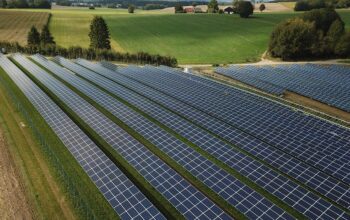When it comes to making the world a little greener, manufacturing is no longer just a box of dull widgets and assembly lines—it’s the heartbeat of some of the most exciting, real-world sustainability stories out there. Think of it as a relay race where every factory, tech lab, and supply chain is passing the baton of eco-friendly innovation to each other. The year 2025 has already started with some remarkable changes, and here’s a look at how industry is stepping up to the challenge of environmental sustainability, while keeping the jargon light and the stories relatable.
Trend 1: Bio-Based and Lower-Impact Materials Take Center Stage
If your average manufacturing plant was a superhero, this year’s theme would be “cape made of corn, not oil.” Companies are ditching the old ways of relying on fossil fuels for their packaging and products, and they’re turning to bio-based materials instead. Imagine potato starch used in snack bags, or mushroom-based foam protecting your fragile gadgets in transit. These aren’t just feel-good ideas; they’re real deals happening in plants and warehouses right now. The shift helps cut down on plastic waste and reduces the carbon footprint of shipping, packing, and selling products across the globe.
Trend 2: The Rise of Real-Time Environmental Impact Monitoring
Picture this: a digital dashboard at a factory, where every ounce of waste, every kilowatt of energy, and every gallon of water is tracked in real time. This isn’t science fiction—it’s 2025. Thanks to advancements in life cycle assessment (LCA) software, manufacturers big and small can now map out their environmental footprint as easily as checking their email. It’s a bit like having a Fitbit for your factory, constantly measuring how “healthy” its eco-impact is. Companies are using these tools to spot inefficiencies, cut down on emissions, and make smarter, more sustainable choices every day.
Trend 3: The Semiconductor Industry’s Big Carbon Question
Every time you swipe your phone, stream a video, or send an email, there’s a tiny chip in your device that’s part of a much bigger story. The semiconductor industry is booming, but it’s also one of the most energy-hungry sectors out there. By 2030, experts predict that semiconductor factories alone could emit almost 280 million metric tons of CO₂—if nothing changes. The reality is, while the chips get smarter, the industry’s footprint is getting harder to ignore. The good news? Companies are starting to tackle the problem head-on, focusing on the most energy-intensive stage—chip manufacturing—and looking for greener ways to get the job done.
Trend 4: Smart, Efficient, and Sustainable Horticulture Tech
Believe it or not, even the way we grow plants is getting a high-tech, eco-friendly makeover. At the heart of professional horticulture in 2025 is a new breed of LED lighting that’s not just bright, but smart and super energy efficient. Companies like ams OSRAM are rolling out lights that use way less power, last longer, and can even be fine-tuned to help plants grow faster and healthier. Picture a greenhouse lit up with these next-gen LEDs, where every watt counts, and every harvest is more bountiful (and greener). It’s a bright spot for sustainable manufacturing, literally.
Trend 5: Predictive Safety and the Circular Economy
Safety and sustainability used to be two separate meetings on a manager’s calendar, but in 2025, they’re sitting at the same table. Factories are turning to predictive tools that not only keep workers safe but also help the company use materials in smarter, more circular ways. For example, let’s say a factory’s maintenance system gets a heads-up that a machine part is about to fail. Instead of waiting for it to break and then throwing scrap metal in a landfill, the system flags it early, so the company can fix it before there’s even a spill or a hazardous risk. This dovetails with the circular economy idea—using less, wasting less, and making sure everything possible gets another life in the supply chain.
Wrapping It Up: Green Is the New Black in Manufacturing
Each of these trends is a piece of the puzzle in making manufacturing cleaner, safer, and smarter. Whether it’s swapping oil for plant-based plastics, watching emissions in real time, tweaking chip factories for less pollution, lighting up greenhouses with super-efficient LEDs, or making safety and material use more circular, the stories are real, and the impact is tangible. For the folks on the ground—be they engineers, floor managers, or supply chain experts—its lessons are the kind they carry with optimism to their daily work. The message is clear: environmental sustainability isn’t just something to talk about at conferences. It’s a hands-on, everyday mission—one that’s already changing the way the world makes things.
References:
- https://www.cdf1.com/midyear-review-the-state-of-sustainable-packaging-and-whats-gaining-momentum-in-2025/
- https://www.globenewswire.com/news-release/2025/05/27/3088516/0/en/Top-10-Growth-Opportunities-Related-to-Sustainability-Development-Goals-in-the-Test-Measurement-Market-2025-Research-Report.html
- https://www.environmentenergyleader.com/stories/whats-next-in-safety-and-sustainability-for-2025,78921
- https://p6technologies.com/lca-trends/
- https://www.techinsights.com/blog/global-semiconductor-carbon-emissions-forecast-2025-2030
- https://ams-osram.com/news/press-release/greentech-2025
- https://www.ttecjobs.com/en/job/new-york/bilingual-customer-service-representative-spanish-english-remote-in-new-york/44028/79803912864
- https://www.weforum.org/stories/2025/05/beyond-compliance-why-sustainability-data-is-now-non-negotiable/



